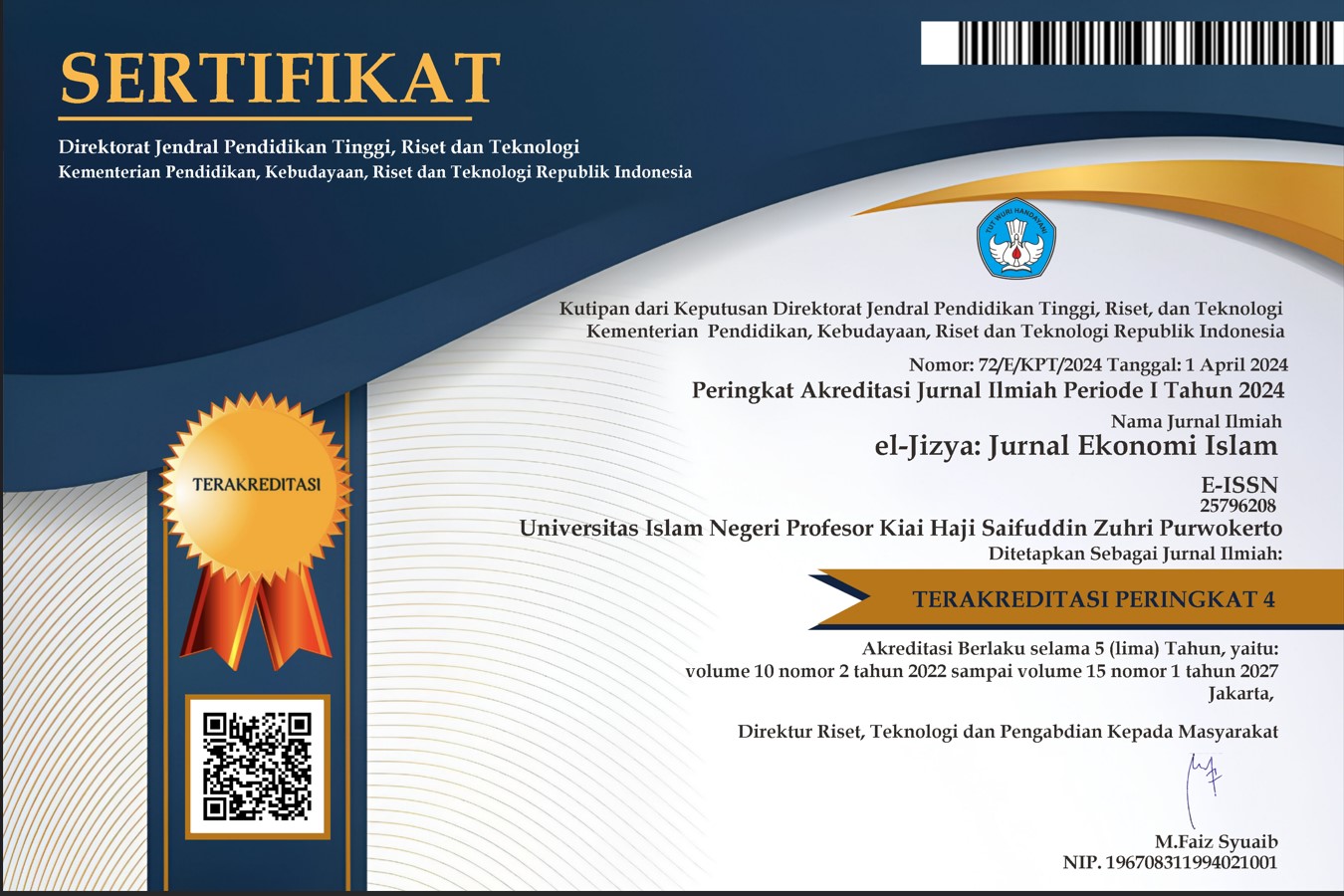Five Feet Traders In The Cross Of Economic History
Five Feet Traders In The Cross Of Economic History
DOI:
https://doi.org/10.24090/ej.v6i2.2040Keywords:
Traders, Street Vendors, Cross, History, EconomyAbstract
Street vendors (PKL) is a form of business that has a high entrepreneurial spirit and is able to compete amid economic competition. The existence of street vendors tends to be motivated by the problem of lack of employment provided by the government, survival efforts, lack of business capital in the formal sector, complicated rules and bureaucracy, temporary work and heredity and profession, making PKL business as an alternative that can be done by the community. Street vendors or in English also called street traders are always included in the informal sector. PKL is a person who trades using a cart or holds his wares on roadside or sidewalks of city streets around shopping centers / shops, markets, recreation / entertainment centers, office centers and education centers, either permanently or half-settled, unofficial status or semi-official and carried out both morning, afternoon, evening and night in order to meet the needs of life by not involving other parties in a binding manner. The term street vendor was first known in the era of the Dutch East Indies, precisely when Governor-General Stanford Raffles came to power. The development of street vendors in the economic history of humankind experienced progress and modernity. Dissatisfaction with government policies related to the allocation of street vendors, gave birth to traders who went to the community directly, which was called the shock market.References
Adam Ramadhan, Implementation of the Street Vendor Management Zoning Model in Bandung City (Pandecta Journal Volume 10. Number 1. June 2015)
Ali Achan Mustafa, The Informal Sector Social History, Theory, and Praxis Models of Street Vendors, (Malang: Trans Publishing, 1996)
Alisjahbana, the Dark Side of City Development (Yogyakara: Laksbang Pressindo, 2006)
Bani Pamungkas, Street Vendors and City Development: Analysis of Jakarta and Kuala Lumpur City PKL Night Market Management Policies (Proceedings of the Indocompac National Seminar at Bakrie University, Jakarta. May 2-3, 2016)
D.J. Rachbini, Economic Development & Human Resources (Jakarta: Publisher: Grasindo, 2002)
Dikri, devi, et al, Street Vendors (Bandung, October 12, 2014)
Dodi Hermanto, et al, Street Traders Social Movement (Humanus Journal Vol. X No. 1 Year 2011)
Eko Handoyo, Existence of Street Vendors (Salatiga: Tisara grafika, 2012)
Hassan, N., Accommodating the Street Hawkers into Modern Urban Management in Kuala Lumpur. In Accomodating the Street Hawkers in Kuala Lumpur. (Kuala Lumpur, 2003)
Henny Purwanti and Misnarti, Controlling and Guiding Street Vendors in Lumajang District. (Journal of the College of Law Sciences (STIH) Jenderal Sudirman Lumajang, 2012)
Islahuddin, The Role of Street Vendors in Overcoming Unemployment in the Perspective of Islamic Economics in Makassar City (Research Department of Islamic Economics, Faculty of Economics and Islamic Business, Alauddin State Islamic University Makassar, 2017)
Jan Breman, The Shattered Image: Construction and Deconstruction of the Village in Colonial Asia, (Holland / USA: Foris Publication, 1998)
Karafir Pieter Yan, Fertilizer Capital Trader Kakilima: Research Case Study in Tanah Abang Area, Jakarta Market. (Jakarta: Social Sciences Training Center, 1998)
Kartono Kartini, Leader and Leadership (Jakarta: Rajawali Press, 2006)
Maria Sri Rahayu, Street Vendor Strategy Against Regional Regulation No. 3 of 2000 (Case Study in Puputan Margarana Denpasar Field) (Journal of the Faculty of Social Sciences Lecturer in the History of IKIP PGRI Denpasar)
McGee, T.G. & Yeung, Y.M, Hawkers in Southeast Asian Cities: planning for the Economy Bazaar (Ottawa: International Development Research Center, 1978)
Nurul Azizah Syam, Implementation of Local Government Policies in Fostering Street Vendors (Case Study on Street Vendors in Paropo Village, Panakukang District, Makassar City) (Research on Political Sciences and Government Sciences, Faculty of Social and Political Sciences, Hasanuddin University, 2016)
Nurvina Prasdika, Portrait of the Life Phenomena of Street Vendors in Bambu Kuning Market Bandar Lampung (Research Faculty of Social and Political Sciences Lampung University Bandar Lampung, 2017)
Presidential Regulation Number 125 of 2012 concerning Structuring Coordination and Empowerment of Street Vendors
Ramadhani Bondan, Implementation of Regulatory Policy, see WWESITE online at the address http://ramadhanibondan.blogspot.com/2015/01/implementasi-keb policy-pengaturan- dan html. accessed 20 October 2018 at 13.30 WIB.
Repository, Characteristics of Street Vendors, blame the online view in the http://repository.usu.ac.id/bitstream/123456789/15826/1/sim-des2004-%20%281%29.pdf address. Access 20 October 2018 at 2:00 p.m.
See "Said", City of Street. PU-Net Public Works Department
Maneepong, C. & Walsh, J.C., A new generation of Bangkok Street vendors: Economic crisis opportunity and threat. (Cities, 34, 2013)
Shvoong, Definition of Street Vendors, see on the website online http://id.shvoong.com/social-sciences/sociology/2205244-defenisi-pedagang -kaki-lima. Accessed 21 October 2018 at 1:00 p.m.
Sri Deti, Empowering the People's Economy through Sharia Microfinance (El Jizya Journal (Journal of Islamic Economics) Vol 5. No 1, January-June 2017)
Sudjana, Method of Statistics (Bandung: Tarsito, 2000)
Udji Asiyah, Stubby Street Vendors in East Java (Journal of Political Society and Culture in 2012).
Ali Achan Mustafa, The Informal Sector Social History, Theory, and Praxis Models of Street Vendors, (Malang: Trans Publishing, 1996)
Alisjahbana, the Dark Side of City Development (Yogyakara: Laksbang Pressindo, 2006)
Bani Pamungkas, Street Vendors and City Development: Analysis of Jakarta and Kuala Lumpur City PKL Night Market Management Policies (Proceedings of the Indocompac National Seminar at Bakrie University, Jakarta. May 2-3, 2016)
D.J. Rachbini, Economic Development & Human Resources (Jakarta: Publisher: Grasindo, 2002)
Dikri, devi, et al, Street Vendors (Bandung, October 12, 2014)
Dodi Hermanto, et al, Street Traders Social Movement (Humanus Journal Vol. X No. 1 Year 2011)
Eko Handoyo, Existence of Street Vendors (Salatiga: Tisara grafika, 2012)
Hassan, N., Accommodating the Street Hawkers into Modern Urban Management in Kuala Lumpur. In Accomodating the Street Hawkers in Kuala Lumpur. (Kuala Lumpur, 2003)
Henny Purwanti and Misnarti, Controlling and Guiding Street Vendors in Lumajang District. (Journal of the College of Law Sciences (STIH) Jenderal Sudirman Lumajang, 2012)
Islahuddin, The Role of Street Vendors in Overcoming Unemployment in the Perspective of Islamic Economics in Makassar City (Research Department of Islamic Economics, Faculty of Economics and Islamic Business, Alauddin State Islamic University Makassar, 2017)
Jan Breman, The Shattered Image: Construction and Deconstruction of the Village in Colonial Asia, (Holland / USA: Foris Publication, 1998)
Karafir Pieter Yan, Fertilizer Capital Trader Kakilima: Research Case Study in Tanah Abang Area, Jakarta Market. (Jakarta: Social Sciences Training Center, 1998)
Kartono Kartini, Leader and Leadership (Jakarta: Rajawali Press, 2006)
Maria Sri Rahayu, Street Vendor Strategy Against Regional Regulation No. 3 of 2000 (Case Study in Puputan Margarana Denpasar Field) (Journal of the Faculty of Social Sciences Lecturer in the History of IKIP PGRI Denpasar)
McGee, T.G. & Yeung, Y.M, Hawkers in Southeast Asian Cities: planning for the Economy Bazaar (Ottawa: International Development Research Center, 1978)
Nurul Azizah Syam, Implementation of Local Government Policies in Fostering Street Vendors (Case Study on Street Vendors in Paropo Village, Panakukang District, Makassar City) (Research on Political Sciences and Government Sciences, Faculty of Social and Political Sciences, Hasanuddin University, 2016)
Nurvina Prasdika, Portrait of the Life Phenomena of Street Vendors in Bambu Kuning Market Bandar Lampung (Research Faculty of Social and Political Sciences Lampung University Bandar Lampung, 2017)
Presidential Regulation Number 125 of 2012 concerning Structuring Coordination and Empowerment of Street Vendors
Ramadhani Bondan, Implementation of Regulatory Policy, see WWESITE online at the address http://ramadhanibondan.blogspot.com/2015/01/implementasi-keb policy-pengaturan- dan html. accessed 20 October 2018 at 13.30 WIB.
Repository, Characteristics of Street Vendors, blame the online view in the http://repository.usu.ac.id/bitstream/123456789/15826/1/sim-des2004-%20%281%29.pdf address. Access 20 October 2018 at 2:00 p.m.
See "Said", City of Street. PU-Net Public Works Department
Maneepong, C. & Walsh, J.C., A new generation of Bangkok Street vendors: Economic crisis opportunity and threat. (Cities, 34, 2013)
Shvoong, Definition of Street Vendors, see on the website online http://id.shvoong.com/social-sciences/sociology/2205244-defenisi-pedagang -kaki-lima. Accessed 21 October 2018 at 1:00 p.m.
Sri Deti, Empowering the People's Economy through Sharia Microfinance (El Jizya Journal (Journal of Islamic Economics) Vol 5. No 1, January-June 2017)
Sudjana, Method of Statistics (Bandung: Tarsito, 2000)
Udji Asiyah, Stubby Street Vendors in East Java (Journal of Political Society and Culture in 2012).
Downloads
Published
31-12-2018
How to Cite
Hadi, N. (2018). Five Feet Traders In The Cross Of Economic History: Five Feet Traders In The Cross Of Economic History. El-Jizya : Jurnal Ekonomi Islam, 6(2), 251–266. https://doi.org/10.24090/ej.v6i2.2040
Issue
Section
Articles
License
Authors who publish with this journal agree to the following terms:
- Authors retain copyright and grant the journal right of first publication with the work simultaneously licensed under a Creative Commons Attribution-ShareAlike License that allows others to share the work with an acknowledgement of the work's authorship and initial publication in this journal.
- Authors are able to enter into separate, additional contractual arrangements for the non-exclusive distribution of the journal's published version of the work (e.g., post it to an institutional repository or publish it in a book), with an acknowledgement of its initial publication in this journal.
- Authors are permitted and encouraged to post their work online (e.g., in institutional repositories or on their website) prior to and during the submission process, as it can lead to productive exchanges, as well as earlier and greater citation of published work (See The Effect of Open Access).















